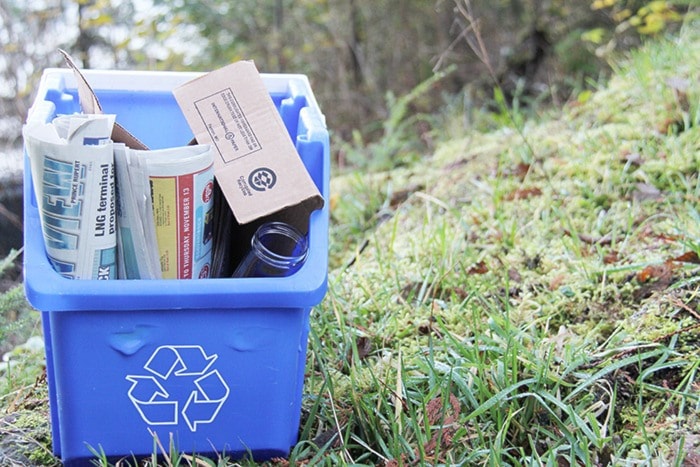Recycling depot management plan received
The North Coast Regional District and the Regional Recycling Advisory Committee toured the regional recycling depot on Dec. 9, 2016 as part of the creation of a regional recycling facility asset management plan, designed to identify issues with the depot, and budget for maintenance and potential growth within the community.
Presently, the depot serves 20,000 North Coast residents from Prince Rupert, Port Edward, Haida Gwaii, Metlakatla and Lax Kw’alaams. In 2015, the depot processed 2,500 tonnes of everything from cardboard to electronics, plastics, metals, tires and paint.
The asset management plan, with a report from Sperling Hansen Associates, calls for three potential growth scenarios moving forward with budgetary items for the program – a low, medium and high growth plan. These various plans are dependent on more residents moving into the region from 0 per cent growth (low) to three per cent growth (high).
In 2017, the depot is forecasted to serve between 20,000 to 26,000 residents, with between 2,700 tonnes and 3,500 tonnes of content recycled.
An evaluation of the recycling building indicates that the structural steel building frame is in good condition with no indication of rust or deterioration and the exterior steel cladding is in acceptable condition, with 15-20 year old fire alarm and security systems and much of the power distribution equipment built in the mid-1970s.
But the concrete slab on grade has some visible cracks, with evidence of roof leaks in many locations, as well as damage to interior walls from moisture and vehicle impact, non-energy efficient indoor and outdoor electrical systems, limited emergency lighting and several observed non-compliances which “can readily be corrected.”
2016’s budget for the depot included a roof membrane replacement, and 2017’s budget includes annual building, equipment and vehicle maintenance, building interior walls and column barriers, concrete floor slab crack repairs, storage bunkers and an emergency lighting upgrade.
The roof was not replaced last year, but there are plans for the replacement moving forward, stated corporate officer Daniel Fish.
“The roof membrane was not replaced in 2016. However, minor repairs did occur. Surplus funds earmarked for replacement will be brought forward into this year’s budget and, dependent on the board’s wishes, likely allocated toward the replacement or repair (as identified in the report) of the roof,” Fish said.
The low and medium growth budget estimates for 2017 are set for $145,000 and the high growth budget estimate is set for $545,000.
The board referred the staff report and the asset management plan to the regional recycling advisory committee for its consideration.
Rebranding project to cost $80,000
Preliminary budget estimates for the North Coast Regional District’s (NCRD) rebranding after its name change from the Skeena-Queen Charlotte Regional District is an $80,000 tab.
The district board resolved to apply for $20,000 in funding from Northern Development Initiative Trust’s Marketing Initiatives Program, which they had been approved once before, but a delay in ministry approval made the funds fall off the table for 2016.
“I’m thinking ‘ouch’ at 80-grand to get a new logo and print some papers and stuff like that, but those are my thoughts,” said director Mike Racz.
NCRD chief administrative officer Doug Chapman said that $32,500 had already been budgeted for the cause in 2016.
“It’s not a full hit on the requisition for taxation for this year. We have partial funding already, so we need $20,000 to top up to the $80,000,” said Chapman.
“It’s about time we polished this place up. It’s become pretty stale,” said director Karl Bergman.
Grant writing moved to dual roles
The regional district’s grant writing position for 2017 will be transitioned to a dual role between the current grant writer on the mainland and another writer located on Haida Gwaii.
The board noted that there were significantly less grant money totals coming into the region in 2016, and that the current grant writer was juggling her duties with another recently acquired full-time job.
“I think moving her to the dual grant-writing structure – having someone able to serve Haida Gwaii and her [keep her functions] on the mainland, I think that would serve her purposes and our purposes well,” said corporate officer Daniel Fish.
Board to apply for CEAA funding
NCRD director Des Nobels requested staff to explore the possibility of receiving participation funding from the Canadian Environmental Assessment Agency (CEAA) for the Aurora LNG environmental assessment application project on Digby Island.
“We are, at present, putting funds out from the regional district with regards to this project and I think it only reasonable that we apply to CEAA for some of that funding to offset our costs with regard to staff and time involved,” Nobels said, adding that many residents in Dodge Cove have been reviewing the application since it was made available.
An open house to comment on the assessment of the project is scheduled for Wednesday, Feb. 8 at 4 p.m. at the Moose Hall in Prince Rupert.
